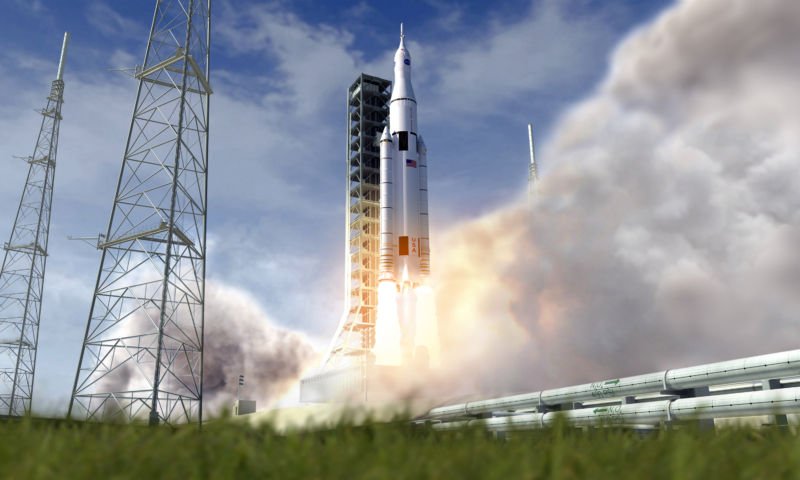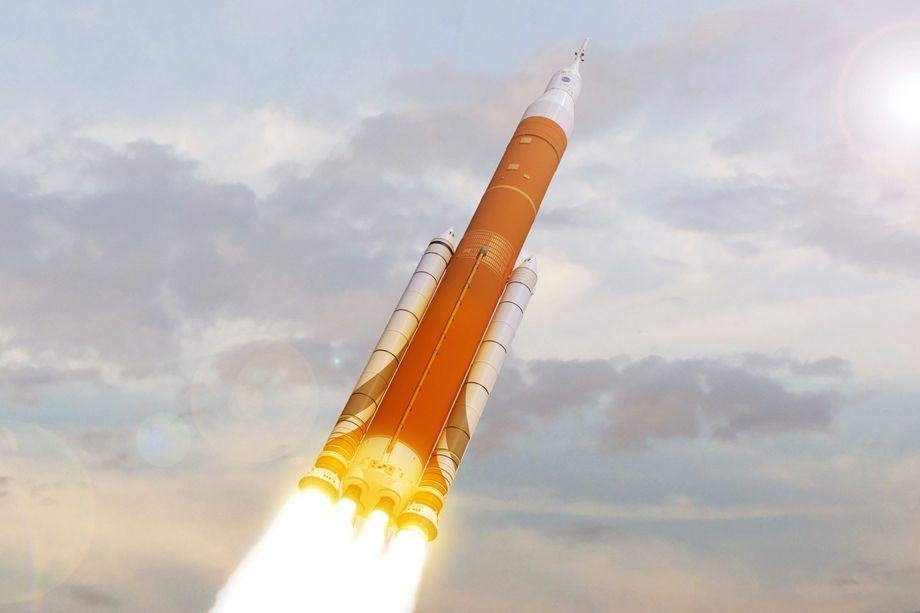
Launch of SLS through the eyes of the artist
Over the next several years, NASA plans to launch its own heavy missiles. It’s about the mission of delivering equipment and people to the moon. Initially, these launches were planned for 2018 and 2021, but, most likely, they will have to be moved to a later date. The development of heavy and super heavy carrier rockets for NASA is engaged in SpaceX and Boeing. As for the latter, its rocket is called Space Launch System (SLS). According to the plan, the rocket should go to flight next year.
According to NASA’s plan, Boeing’s Boeing SLS and SpaceX Orion capsules were to be tested in the timeframe. In November 2018, a heavy Boeing missile should bring the Orion capsule to the lunar orbit. The flight must be automatic, it will allow without risking people to experience all systems. And already in 2021 a second flight is planned, with a team of people. The flight duration is 8 days, the number of team members is 4.
Now the agency is working on the installation of ground structures on the launch pad. So the preparation of both missions is moving forward. In particular, work is underway to create a mobile launch platform for SLS, and the various structures of the launch pad at Cape Canaveral, at the Kennedy Space Center, are being modernized and changed according to the needs of new missions.
In addition, the program may have changes related to everything that was said above. For example, the first unmanned flight can be canceled, a capsule with people will fly to the Moon. Now NASA is exploring the possibility of carrying out a manned flight to the moon, trying to foresee all the troubles that can happen. But all this has not yet been confirmed, it is only about alleged, not approved actions. If it is decided to send people into space within the first mission, the agency will have to take on not only additional risks, but also additional costs. “Preliminary assessment shows that this will require significant additional costs – money that is not so easy to get,” said Bill Hill, a NASA spokesman.
The presidential administration asked the NASA management to assess the risks of changing plans. According to the agency’s management, if it turns out that sending people into space within EM-1 is too dangerous, then the former plan will be left in force and the first launch will be automatic.
In a rapid pace to refine the upper stage of the rocket for a manned flight, add a life support system for astronauts, modify the Orion capsule. “We will have to sort out what has already been done and modify the system to add the life support system that is needed for the flight,” says Jason Crusan, the head of one of NASA’s divisions.
All work on the flight to the moon is just preparation for a larger, that is, manned expedition to Mars with the landing of people. In any case, so state in NASA. The transfer of flights to the Moon, of course, also affects the flight program to Mars, the terms are shifted to a later date. Part of this program is the creation of modules for the Deep Space Gateway, a station located near the Moon, which will serve as an intermediate stage for flights to the Moon and Mars.

There are a lot of gaps in the whole program. The timing of the implementation of a number of stages is unknown, the cost of creating the above modules and other devices and structures is unknown. As a result, the US government strongly recommends that the agency quickly decide on the plan, focusing on the implementation of its previously planned stages.
By the way, an important aspect of all this is money. Already, NASA has spent more than $ 15 billion on the Martian program. It is believed that by 2033 the cost will reach $ 210 billion. Therefore, now the government asks the agency to think about where to save money. In addition, the administration of President Trump wants to show tangible results of his work during the first presidential term of Donald Trump.








